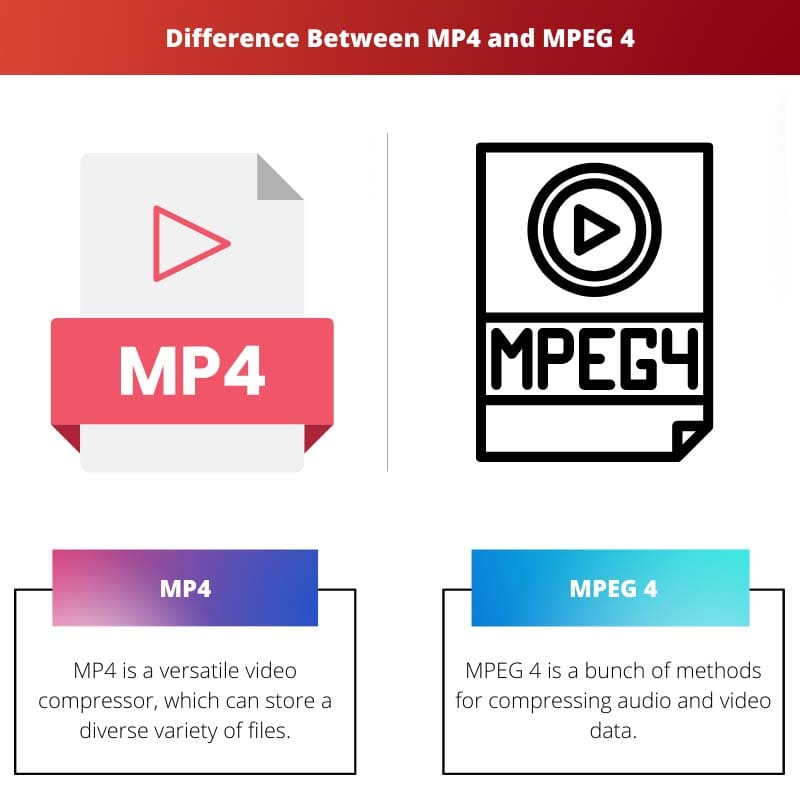Technology helped us to change as a society, and this happened not only because of the tall skyscrapers or the space missions but also because of the much smaller things.
The fact that we all have a personalised collection of thousands of memories we make is also a boon of technology.
The invention of modern computers was complimented very well by online media compressors and storage formats.
Most came into being in the latter part of the last century.
MP4 and MPEG 4, mistaken for the same, were pioneer inventions in the same field.
The former is considered an abbreviation of the latter, though it’s far from the truth.
Key Takeaways
- MP4 and MPEG-4 refer to digital video formats for storing and transmitting video and audio data.
- MP4 is a specific format widely used for compressing and streaming video content over the internet, while MPEG-4 is a standard that defines various formats and codecs for digital video.
- MP4 is a subset of MPEG-4 and uses the H.264 codec for video compression, while MPEG-4 supports multiple codecs and offers more flexibility in encoding and decoding video content.
MP4 vs MPEG 4
MP4 and MPEG-4 (Moving Picture Experts Group 4) are video file formats. MP4 is a specialized format that works with various devices, but MPEG-4 is a universal format that supports a variety of encoding methods.

Comparison Table
| Parameters of Comparison | MPEG4 | MP4 |
|---|---|---|
| Use | Generally used for sharing video content on the internet | A media container which compresses audio, video and various other files. |
| Developed by | Moving Pictures Experts Group | International Organization for Standardization. |
| History | It started in 1998 for coding AV formats. | Created in 2001 and is based on Apple’s MOV format |
| Advantages | Has higher compression rates with minimal usage of bandwidth | The quality of the video is left unaffected after compression, irrespective of its size. |
| Disadvantages | A higher amount of compression might result in the video losing its quality. | It can be easily misused for downloading videos online. |
What is MP4?
A common file platform used for streaming or downloading videos from the internet. MP4 is a versatile video compressor which can store various files.
It contains audio, video, subtitle files, information on the audio-video sync time, thumbnail files, etc.
MP4 (MPEG-4, part 14) was created in 2001 by the Motion Pictures Experts Group (MPEG) and ISO/IBC. MP4 is the container of data and not an encoder in itself.
One of the major positives of MP4 is that the file size is much smaller than the video format. Besides, the quality is retained as it doesn’t deplete when the file size is reduced.
MP4 can also store data other than audio, video, and speech. It is more suitable for online streaming videos and maintains good quality even after compressing a large amount of data.
Besides, the compression of high-quality videos does not degrade the audio quality. More importantly, MP4 can render high-quality videos at 1 MB/Sec or even less (with preset internet service).
Though, MP4 files, like MP3, are difficult to edit and update. Also, in this time and age, with movies being available at paid online streaming platforms, MP4 is used to download video content online illegally.
Some of MP4’s features are –
- MP4 is an Open standard file, making it easy for everyone to use.
- The original quality of the video remains intact.
- Most of the applications support this format.
- MP4 is the go-to option for streaming videos online.
- It supports many different Operating Systems, making it easy to distribute.

What is MPEG 4?
Introduced in 1998, MPEG 4 is a bunch of methods for compressing audio and video data. MPEG 4 covers a rather broad range across different mediums: broadcast television, telephone, and CDs.
MPEG 4 is not only an amalgamation of MPEG 1 and 2 but also has many of its exclusive features. VRML assistance for 3D rendering and object-oriented files are some of its unique features.
MPEG 4 is extremely developer-friendly and flexible.
It allows developers to use all its features, not necessarily in its holistic nature.
This flexibility increases the probability of all the set standards of MPEG 4 not being used at once.
MPEG 4 supports 3D rendering and stage description.
This feature is specifically useful while making presentations. It functions smoothly, even with low bandwidth. Added to this, multiple devices and media containers support MPEG 4.
MPEG 4 can also enhance your video-watching experience online by adding still graphics, visual elements, and animation. It also enables robust transmission and encodes mixed audio and video data.
Plus, the Superior Coding efficiency is also a major positive
Following some of its major features –
- Profiles – Different profiles are offered for different applications.
- Interoperability – This standard is not platform-specific but designed for all platforms.
- Scalability – Gives space for flexibility in coding the bit stream methods.
Although MP4 containers shelter the encoded video data in MPEG4, they cannot manipulate the quality. It has more to do with the storage of the different complementary files of the video.
Converting MPEG4 into MP4
MPEG 4 is an umbrella term for different data containers; if your device doesn’t support any of its containers, you would want to turn to MP4.
Many media players do not support the MPEG 4 format.
At times, when your file is in MPEG 4 format and needs to be edited, converting it to MP4 is the only viable option at hand.
There are plenty of methods and applications online which can be helpful in this process.

Main Differences Between MP4 and MPEG 4
- MPEG 4 is used for the compression of Audio and Video data online. It is also used in broadcast television applications and CD distribution.
- MP4 is a media container developed by the International Organization for Standardization. It contains audio, video, and text data. MP4 is extended from MPEG 4, part 12.
- MPEG 4 is a video encoding algorithm that compresses and converts AV data. MP4, on the other hand, is a container of the already compressed media.
- MP4 has nothing to do with the conversion of the data; it is only concerned with storing various files related to the same (subtitle, audio, AV sync, etc.)




